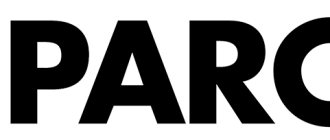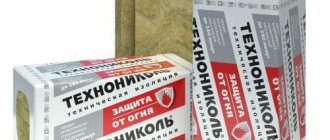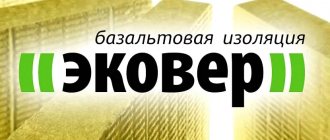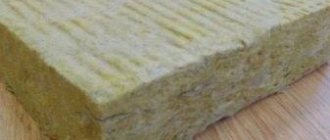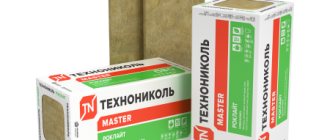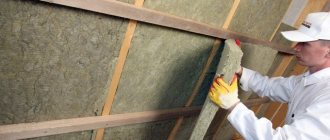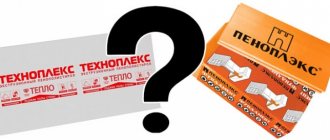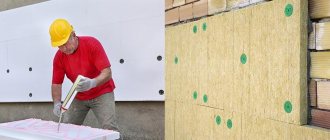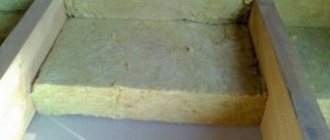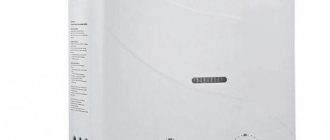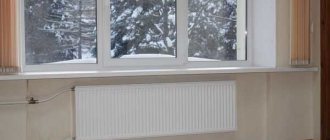In the cartoon about Alyosha Poppovich, he had three paths. Today there is more choice when choosing insulation. However, it is THREE manufacturers that especially stand out: Knauf, Rockwool and our guest today, TechnoNikol insulation products.
The TechnoNikol company was founded in 1993 and today, almost 24 years later, it is the market leader in the field of building materials, in our case thermal insulation. The photo below shows how mineral wool production increased from 2003 to 2015.
Someone will immediately say that in the case of well-known brands you need to overpay for the name, but in an era of crisis this is a very controversial issue. In general, the premium for time-tested quality is worth the nerves and extra effort spent on “fighting” with bad materials made “on the knee”. But, in an era when every manufacturer is fighting for every customer, such markups are becoming a thing of the past.
The company produces materials that are used at very serious facilities:
- Alexandria Theater; Saint Petersburg;
- Torgovy, Nizhny Novgorod;
- Drama Theatre, Omsk;
- St. Petersburg State Technical University, St. Petersburg;
- Trade St. Petersburg;
- Konstantinovsky Palace, St. Petersburg;
- Crimean Bridge, Moscow.
The company produces thermal insulation from two main materials:
- Mineral wool;
- Expanded polystyrene.
Basalt wool, names
Insulation materials made from cotton wool are produced in ten main directions:
- AXI,
- BASALT,
- TECHNOACUSTIC,
- ROCKLIGHT,
- TECHNOBLOCK,
- TECHNOVENT,
- TECHNOLIGHT,
- TECHNORUF,
- TECHNOFAS,
- TECHNOFLOOR.
Of course, each direction represents a material for a specific application. Some types are more or less universal insulation materials. For example, Technofas, as the name suggests, is a slab for facade insulation from TechnoNikol.
Stone wool is produced at factories in Cherkassy, Rostov-on-Don, Zainsk and Chelyabinsk. [flat_ab id=”33″]
Variety of TechnoNIKOL insulation materials
Thermal insulation of domestic manufacturers is represented by two main classes of insulation: mineral wool and extruded polystyrene foam .
TechnoNIKOL mineral wool consists of the finest threads of rocks. Between the weaves of basalt there are air cells. This combination provides excellent performance. Stone threads are responsible for the strength and fire resistance of the material, and many air cells give basalt slabs the necessary heat capacity .
Extruded polystyrene foam (EPS) is produced by combining styrene with special foaming additives. All components are mixed under high heat and pressure. The prepared mass is passed through an extruder - the output is slabs with a smooth surface .
Competitive advantages of EPS: light weight, ease of installation and rigidity . Excellent strength characteristics make it possible to use polystyrene foam in areas where a soft thermal insulator is not suitable. The disadvantages of EPS are flammability and the release of acrid smoke when burning.
Characteristics of stone wool
In general, the features of TechnoNikol stone wool and its technical characteristics are very similar. Basically, when choosing a material, it is worth considering:
- Manufacturer's recommendations;
- Density (hardness);
- Material type.
The manufacturer initially recommends certain types of insulation for specific tasks. For example, Technoacoustic slabs are used to soundproof interior partitions. In the video below, at 6 minutes 31 seconds, the manufacturer recommends Rocklight for attic insulation.
And TechnoNikol recommends Technofas as facade insulation. If there is a need to insulate the foundation, TechnoNikol recommends Technoruf. In general, foundation insulation should be carried out using hard mineral wool slabs.
Density is the second important factor that affects the area of application of cotton wool. There are three main types of wool layout:
- Mats (rolls);
- Soft slabs;
- Rigid slabs;
Mats or rolls are used to insulate the floor in the attic or it can be laid between floors. Insulating the walls of balconies and loggias may require the use of rigid slabs if there is no possibility or desire to use lathing.
Types of TechnoNIKOL cotton wool
Today, this company produces several types of basalt wool intended for different purposes. So, for example, the Tekhnoruf option can be used for roof insulation, and Tekhnofas for the facade . Technoacoustic wool is used for soundproofing doors, ceilings, etc. The most popular type of slab is a universal material with moisture-resistant additives, which can be used for insulation or soundproofing of almost any structure.
How much does TechnoNikol mineral wool cost?
The characteristics of TechnoNikol insulation also include cost. In this section we provide the approximate cost of the most popular TechnoNikol stone wool insulation.
| Name | Size | Thickness | Number of slabs per package | Square | Price | Price 1 sq. meters |
| Rocklight | 1200Х600 mm | 50 mm | 12 | 6,91 | 514 rub. | 74 rubles |
| Technoblock PROF | 1200Х600 mm | 80 mm | 6 | 6,91 | 918 rub. | 133 |
| Technolight Optima | 1200Х600 mm | 50 mm | 12 | 8,64 | 603 | 70 |
| Technofas Optima | 1200Х600 mm | 50 mm | 6 | 4,32 | 951 | 220 |
| GreenGuard insulation | 1200Х600 mm | 50 mm | — | 5,76 | 400 | 69 |
Mineral wool thermal insulation cylinders TechnoNikol brand CF 80 measuring 1200 by 20 mm and a diameter of 18 mm cost 50 rubles as of January 2022.
It is easy to notice that materials are available in different price segments. On the TechnoNikol website there is a division into three types of basalt wool: economy, standard and premium. Of course, everything depends not only on financial capabilities, but also on the needs of a particular home.
Why choose TechnoNikol products
TechnoNikol basalt insulation is very popular among builders, as it has the following advantages:
- Low thermal conductivity.
The finest interwoven fibers, representing the structure of the material, hold a large volume of air, which remains in a stationary state. As a result, the resistance to heat transfer increases significantly, so in the cold season the room is warm, and in the heat it is cool.
- Long service life.
Stone wool is able to perform its function throughout the entire service life of the building without losing its original properties.
- Protection from aggressive environments.
The insulation does not interact chemically with other materials and many compounds.
- Resistance to biological factors.
Basalt wool does not rot, does not serve as a favorable environment for the development of fungi, and is not food or shelter for rodents.
- Manufacturability.
The material can be easily processed with hand-held cutting tools and is easy to install.
- Environmentally friendly.
All components of the heat insulator are safe for human health and the environment. Production waste is reused.
- Vapor permeability.
Air easily penetrates through the fibrous structure of the insulation, so moisture does not accumulate in it, and a comfortable microclimate is created in the room.
- Non-flammability.
The insulation is based on rocks with a melting point above 1000℃.
- High sound insulation characteristics.
Sound waves are effectively absorbed by the fine-porous structure, which allows the insulation to be used as a sound insulator.
- Hydrophobicity.
The use of special water-repellent additives during production makes the material water-repellent. This has a positive effect on its ability to retain heat.
The concept of thermal conductivity of materials
Any bodies, gaseous, liquid media, when in contact with each other, tend to equalize the temperature of the molecules of which they are composed. The exchange of energy between particles of different materials is called thermal conductivity.
For example:
- in winter, cold street air tends to equalize the indoor temperature;
- why does it take thermal energy from the walls of buildings;
- which is transmitted to them by air heated from the registers of heating devices.
The positive thermal conductivity coefficient of extruded polystyrene foam means energy transfer only in the direction of increasing temperature. Substances with a negative TP coefficient lower the ambient temperature (inert gases used in climate control equipment).
In construction, materials are used that can prevent heat loss and protect the home from the cold. Therefore, the thermal barrier must be continuous so that there are no cold bridges that negate the efforts to insulate the building.
Fig.2 Comparison of thermal conductivity of structural and thermal insulation materials
TechnoLIGHT Optima
Mineral wool insulation Technolight Optima is a modern soundproofing insulation material that is actively used on horizontal, vertical, and inclined surfaces (not experiencing high physical stress). Insulation boards are actively used in work with attic-type superstructures, roofs of buildings (with ventilated covering), attics, attic floors, etc. This material is well suited for the construction of partitions in rooms, as a result of which minimal audibility is achieved between shared rooms. This material will last for many years without changing its quality characteristics. The non-combustibility of Technolight Optima insulation will provide high fire protection characteristics for any type of use (floor, partition, etc.).
Technical characteristics of TechnoLIGHT Optima slabs
| Average density, kg/m3 | 38 |
| Thermal conductivity of plates (10°C), W/(m°C) no more | 0,033 |
| Thermal conductivity of plates (25°C), W/(m°C) no more | 0,037 |
| Thermal conductivity of slabs (operating conditions A), W/(m°C) no more | 0,039 |
| Thermal conductivity of slabs (operating conditions B), W/(m°C) no more | 0,041 |
| Vapor permeability of slabs, mg/(m.h.Pa) not less | 0,3 |
| Humidity by weight, percent, no more | 0,5 |
| Water absorption by volume, percent, no more | 1,5 |
| Content of organic substances, percent, no more | 2,5 |
| Flammability degree | NG |
Price
RUR/pack
786
from
Thermal conductivity coefficients
All durable components are gradually heated, and then cooled, in compliance with the intervals, the temperature regime of the internal structure and surface of the material. The thermal insulation qualities of mineral wool are demonstrated by the thermal conductivity coefficient. Its smallest value ensures maximum preservation of thermal conductivity. Often the coefficient values are pre-specified by the manufacturer. The value of the coefficient is determined in laboratory conditions.
Thermal water values vary around 0.032 W/(m*K). The latter indicator is found only in high-quality insulation materials.
How it is made
When producing TechnoNIKOL mineral wool, the rock is pre-loaded into melting furnaces and heated to a temperature of 1400-1500 degrees. Next, the molten rock mass is poured into a special centrifuge.
Here, spinning tops rotating at speeds of up to 7000 rpm tear it into small fibers. During this procedure, binders are poured into the centrifuge
. At the next stage, the fibers already impregnated with phenol-formaldehyde resin enter the lamella machine and are formed into a carpet of a given thickness.
Mineral wool of the TechnoNIKOL brand is manufactured by the domestic company of the same name, founded at the end of the last century. Currently it includes more than 20 enterprises and 120 retail outlets
operating throughout the country. Mineral wool from this manufacturer is made from high-quality materials using modern equipment, and therefore is extremely popular not only in Russia, but also abroad.
Technical characteristics of mineral wool
This type of modern thermal insulation materials has unquestionable advantages and excellent technical parameters in comparison with conventional insulation:
- minimal absorption of water and moisture;
- ability to withstand high loads;
- long service life, which reaches 50 years, thanks to the use of extrusion;
- easy and convenient installation work;
- excellent sound insulation performance, which is achieved due to the unique structure of the fibers;
- saving heat for a long period of time;
- basalt wool is capable of restoring its original shape after compression.
Mineral wool is produced in sizes convenient for installation; it is resistant to high and low temperatures, which significantly increases its service life. Does not contain any hazardous substances that may pose a threat to health.
Indicator table
For ease of work, the thermal conductivity coefficient of the material is usually entered into the table. In addition to the coefficient itself, it can reflect such indicators as the degree of humidity, density and others. Materials with high thermal conductivity are combined in the table with indicators of low thermal conductivity. A sample of this table is shown below:
Using the thermal conductivity coefficient of the material will allow you to build the desired building. The main thing: choose a product that meets all the necessary requirements. Then the building will be comfortable for living; it will maintain a favorable microclimate.
Properly selected will reduce the reason why you will no longer need to “heat the street”. Thanks to this, financial heating costs will be significantly reduced. Such savings will allow you to soon return all the money that will be spent on purchasing a heat insulator.
Basalt wool for ceilings is an environmentally friendly and economical material. It is made from natural raw materials. Minerals of the basalt group are subjected to high-temperature (more than 1000 °C) processing. The result is the finest (1-7 microns) fibers that form a chaotic structure. Special polymer resins are used to hold them together.
The chaotic structure causes the presence of a large number of channels filled with air. This explains the good heat and sound insulation properties of the material. The thermal conductivity of basalt wool from different manufacturers is at the level of 0.035-0.042 W/m K. At the same time, it is capable of blocking 80-100% of external sounds.
The decision to buy basalt wool for the ceiling is also explained by its other positive characteristics:
- non-flammable - the material does not support combustion and cannot be a source of fire;
- biological inertness - during operation it will not become a habitat for bacteria or microorganisms;
- chemical resistance;
- stability of shapes and sizes - over time the material does not shrink and does not change its geometry;
- ease of installation;
- durability - the minimum service life of basalt insulation declared by manufacturers is 40-50 years.
For many consumers, an important positive factor is the attractive price of basalt wool for the ceiling.
Which material to choose
Basalt wool is sold for insulating ceilings in the form of mats (slabs) or rolled material with a density of 30-80 kg/m³. According to users, the former are more convenient during installation. When determining the required thickness of insulation, you should take into account the climate zone where the house is located, the type of base material and structural features. In most regions of Russia, a layer of basalt wool of 10-15 cm will be sufficient. To ensure sound insulation of an apartment, a material 3-5 cm thick will be required.
Installation features
In order for basalt wool for the ceiling to provide reliable heat and sound insulation, it is important to carry out the installation correctly. At the initial stage, cracks and other significant damage are eliminated and the sheathing is arranged
The latter can be made of metal profiles or wood. When using wood, it should be treated with an antifungal agent. The pitch of the sheathing depends on the width of the insulation used.
Everyone wants to live in comfort and peace. If owners of private houses set this goal, then they try to protect their home from extraneous noise and cold with the help of special materials. If you are looking for protection from winter cold and summer heat, you can use thermal insulation based on mineral wool. This material is offered for sale in several varieties, each of which has its own pros and cons, so you need to study them before making a purchase.
TechnoLIGHT EXTRA
TECHNOLIGHT Extra slabs are non-flammable, hydrophobized sound and heat insulating slabs made from mineral wool (based on basalt group rock).
TECHNOLIGHT slabs are used at temperatures ranging from minus 60 °C to plus 400 °C. The high melting point of insulation fibers (more than 1000°C) determines its non-flammability property.
Technolight Extra slabs are produced using the most modern technologies, which allows us to obtain an environmentally friendly product that is safe for human health and life. The production of Technolight Extra insulation is carried out from basalt mineral fibers, bonded with a specially prepared organic binder (to increase the thermal insulation properties of the slabs, strength, elasticity, etc.). Thanks to the binder, the material acquires water-repellent properties and durability. This material is neutral to chemical influences with various substances and does not attract rodents (insects).
Technical characteristics of Technolight Extra insulation:
| Average density, kg/m3 | 34 |
| Thermal conductivity of plates (10°C), W/(m.oC) no more | 0,036 |
| Thermal conductivity of plates (25°C), W/(m.oC) no more | 0,038 |
| Thermal conductivity of slabs (operating conditions A), W/(m.oC) no more | 0,039 |
| Thermal conductivity of slabs (operating conditions B), W/(m.oC) no more | 0,04 |
| Vapor permeability of slabs, mg/(m.h.Pa) not less | 0,30 |
| Humidity by weight, percent, no more | 0,5 |
| Water absorption by volume, percent, no more | 1,5 |
| Content of organic substances, percent, no more | 2,5 |
| Flammability degree | NG |
Purpose, area of application of Technolight Extra insulation:
Building structures of buildings and structures (industrial and civil) very often require additional thermal and sound insulation. TECHNOLITE Extra slabs, designed for surfaces that do not bear large external loads, will help them with this. Insulation boards are actively used in work with attic-type superstructures, pitched roofs of buildings (with ventilated covering), attics, attic floors, floors with insulation laid between joists, partitions, frame walls, etc. TECHNOLITE Extra boards are recommended for use on both horizontal and vertical surfaces and on inclined surfaces.
Price
RUB/UP
902
from
TechnoVENT
TECHNOVENT is a non-flammable, hydrophobized heat- and sound-insulating slab made of mineral wool based on basalt group rocks with a low-phenolic binder.
TECHNOVENT slabs are intended for use in industrial and civil construction as a heat and sound insulation layer in ventilated facade systems.
Main technical characteristics of TechnoVENT thermal insulation boards
| Indicator name | Unit measurements | TECHNOVENT STANDARD | TECHNOVENT OPTIMA | TECHNOVENT PROF | |
| Tensile strength, not less | kPa | 3 | 5 | 8 | |
| Flammability | degree | NG | NG | NG | |
| Thermal conductivity | λ25 | W/m•S | 0,036 | 0,036 | 0,037 |
| λ A | 0,038 | 0,038 | 0,039 | ||
| λ B | 0,039 | 0,040 | 0,041 | ||
| Compressibility, no more | % | 2 | 2 | 2 | |
| Compressive strength at 10% deformation, not less | kPa | 10 | 12 | 15 | |
| Vapor permeability, not less | mg/(m•h•Pa) | 0,3 | 0,3 | 0,3 | |
| Humidity by weight, no more | % | 0,5 | 0,5 | 0,5 | |
| Water absorption by volume, no more | % | 1,5 | 1,5 | 1,5 | |
| Content of organic substances, no more | % | 3,0 | 3,0 | 3,0 | |
| Density | kg/m3 | 72-88 | 81-99 | 90-110 | |
Technovent OPTIMA basalt insulation is a non-flammable, hydrophobized mineral slab of increased rigidity made of mineral wool (mineral wool) based on basalt group rocks for insulation and sound insulation of ventilated facades.
TECHNOVENT Optima basalt insulation is intended for use as an insulation layer in curtain wall systems with an air gap. The insulation can be used for single-layer facade insulation and as the top layer of insulation for double-layer thermal insulation. The increased density allows the use of TECHNOVENT Optima insulation with facade insulation systems without windproof film.
TECHNOVENT Optima basalt mineral wool insulation (mineral wool) has increased density and excellent physical and mechanical properties, ensuring reliable operation of the insulation in vertical enclosing structures of insulation systems for ventilated facades for a period of more than 50 years.
TECHNOVENT Optima insulation is environmentally friendly, non-flammable (NG), has high sound insulation properties and does not change its properties over time. Due to its high vapor permeability, the insulation allows excess moisture to be removed from the room. The main advantages of TECHNOVENT Optima insulation are:
- Low thermal conductivity;
- High physical and mechanical characteristics;
- Low water absorption;
- The insulation can be used without windproof films
- Neutrality in contact with concrete and metal materials;
- Fire safety (NG group)
Technovent STANDARD is a highly reliable, durable, special mineral wool insulation for ventilated facades. Its use guarantees a long period of heat and sound insulation without replacement or new financial investments. Technovent STANDARD – for the best facades they choose the best insulation!
TechnoVENT PROF
TECHNOVENT PROF mineral wool board is a non-flammable, hydrophobized heat and sound insulating board made of mineral wool based on basalt group rocks. TU 5762-043-17925162-2006
Scope of application of Technovent PROF In civil and industrial construction as a thermal insulation layer during the construction and reconstruction of buildings and structures for various purposes. TECHNOVENT PROF mineral wool boards are intended for use as a thermal insulation layer in insulation systems with a ventilated air gap of external walls of buildings (ventilated facades).
Basalt mini-slab Technoblock produced by TechnoNIKOL for facade
Mineral wool slabs TECHNOBLOCK manufactured by TechnoNIKOL are used as thermal insulation, sound insulation of various types of layered masonry, frame walls (including external ones) with various types of finishing (including siding). TECHNOBLOCK insulation has an average density of 45 kg/m3 and good rigidity, sufficient to use it as the first (internal) thermal insulation layer in suspended ventilated facade structures with an air gap with a two-layer insulation scheme.
Classification of expanded polystyrene
Regular foam
Thermal insulation material obtained by foaming polystyrene. As mentioned above, its volume is 98% air, which is sealed into granules. This speaks not only of its excellent thermal insulation qualities, but also of its sound insulation properties.
The main advantage of the material is the lack of ability to absorb moisture. In addition, it does not rot or biodegrade. Durable material, light weight and easy to use. It can be glued to any building material.
Expanded polystyrene is easy to burn, but it contains a substance called a fire retardant. This is what gives the foam the ability to self-extinguish. In addition, expanded polystyrene cannot be used to insulate facades. This is due to its low vapor permeability. And in order to carry out work with foam plastic under the roof, you should carefully consider the ventilation system.
Use depending on the brand of material
- PSB-S 15. The marking of polystyrene foam indicates that it can be used to insulate structures that are not subject to mechanical stress. For example, insulation of the roof, the space between the slings and the ceiling.
- PSB-S 25 and 25F. Common markings for polystyrene foam. It says that any surface can be insulated. Walls, facades, ceilings or flooring, roofing.
- PSB-S 35 and 50. This material can be used to insulate objects that are under constant high load.
TechnoFAS
Price
RUB/UP
1080
from
TECHNOFAS boards are intended for use in civil and industrial construction as heat and sound insulation in external wall insulation systems with a protective and decorative layer of thin-layer plaster. The peculiarity of TECHNOFAS boards is their high peel strength.
| Indicator name | Unit measurements | TECHNOFAS | Test method | |
| Ultimate peel strength of layers (laminar strength), not less | kPa | 15 | GOST R EN 1607 | |
| Flammability | degree | NG | GOST 30244 | |
| Thermal conductivity | λ25 | W/m·S | 0,038* | GOST 7076 |
| λ A | 0,040* | GOST 7076 SP 23-101-2004 | ||
| λ B | 0,042* | GOST 7076 SP 23-101-2004 | ||
| Compressive strength at 10% deformation, not less | kPa | 45 | GOST R EN 826 | |
| Vapor permeability, not less | Mg/(m h Pa) | 0,3 | GOST 25898 | |
| Humidity by weight, no more | % | 0,5 | GOST 17177 | |
| Water absorption by volume, no more | % | 1,0 | GOST R EN 1609 | |
| Content of organic substances, no more | % | 4,5 | GOST R 52908-2008 (EN 13820-2003) | |
| Density | kg/m3 | 131-159 | GOST R EN 1602 | |
Price
RUB/UP
1240
from
Basalt insulation TECHNOFAS EFFECT is a rigid, non-flammable, hydrophobized mineral wool board (mineral wool) based on basalt group rocks for insulation and sound insulation of plaster facades.
Characteristics of TECHNOFAS EFFECT insulation:
- Density, kg/m3 — 131-135
- Thermal conductivity at 10°C, no more than W/(m °C) - 0.037
- Thermal conductivity at 25°C, no more than W/(m °C) - 0.038
- Thermal conductivity λA, no more than W/(m °C) — 0.040
- Thermal conductivity λB, no more than W/(m °C) - 0.042
- Compressive strength at 10% deformation, kPa no less - 45
- Tensile strength, kPa not less than - 15
- Vapor permeability, not less than Mg/(mchPa) - 0.3
- Flammability - NG
Price
RUB/UP
1080
from
Technofas Cottage insulating boards are used for external insulation of walls up to 10 meters high. The material is created from basalt mineral wool with a low-phenolic binder, thereby achieving optimal technical characteristics and price per m3. The boards are resistant to temperature, humidity, and other external factors. They are unpretentious in operation and installation.
| Indicator name | Unit measurements | TECHNOFAS COTTAGE |
| Ultimate peel strength of layers (laminar strength), not less | kPa | 10 |
| Flammability | degree | NG |
| Thermal conductivity | λ25 | 0,037 |
| λ A | 0,039 | |
| λ B | 0,041 | |
| Vapor permeability, not less | mg/(m h Pa) | 0,3 |
| Humidity by weight, no more | % | 0,5 |
| Water absorption by volume, no more | % | 1,5 |
| Content of organic substances, no more | % | 4,5 |
| Density | kg/m3 | 95-115 |
| Compressive strength at 10% deformation, not less | kPa | 20 |
Price
RUB/m3
5064
from
Rocklight mineral wool insulation
Rocklight mineral wool is a non-flammable slab with low thermal conductivity, made from basalt rocks; the material is intended for work on heat and sound insulation of residential and industrial premises. Ease of installation and good performance qualities were appreciated by numerous specialists and many craftsmen and private developers.
Rocklight slabs are designed for heat and sound insulation of building structures of residential buildings and industrial buildings in which the insulation does not support external loads.
Recommended for use as insulation in horizontal, inclined and vertical structures, such as: ventilated coverings of pitched roofs, attics, attic floors, floors with insulation installed between joists, walls finished with siding (layered masonry), frame walls and partitions. Distinctive features of Rocklight mineral wool
- Rocklite does not react with alkali and metal.
- Has low water absorption.
- Not attractive to insects and mice, not susceptible to fungi.
- It is environmentally friendly and breathable.
Specifications
| Indicator name | Value for ROCKLITE grade slabs |
| Density, kg/m3, no more | 30 |
| Compressibility, % no more | 30 |
| Thermal conductivity at 25 °C, W/(m K), no more | 0,042 |
| Thermal conductivity under operating conditions A, W/(m K) no more | 0,048 |
| Thermal conductivity under operating conditions B, W/(m K) no more | 0,051 |
| Water absorption at full immersion, % by volume, no more | 1,5 |
| Content of organic substances, % by weight, no more | 2,5 |
| Flammability, degree | n/a |
Price
RUR/pack
530
from
Mat TechnoNIKOL Teploroll
TEPLOROLL is a lightweight, hydrophobized, non-flammable heat and sound insulating mat made of mineral wool based on basalt group rocks. This is a universal material for private construction.
Application area
The TEPLOROLL material is recommended for use in cottage and low-rise construction as heat and sound insulation of horizontal, inclined and vertical structures, such as attics, frame walls, walls with siding, floors and ceilings, partitions.
Advantages
- Convenience and ease of installation
- High installation speed
- Ease of transportation
Basic physical and mechanical characteristics
| Parameter name | HEATROLL |
| Compressibility, % no more | 55 |
| Flammability group | NG |
| Thermal conductivity at 10 °C, W/(m.°C) no more | 0,036 |
| Thermal conductivity at 25 °C, W/(m.°C) no more | 0,038 |
| Thermal conductivity under operating conditions A, W/(m°C) no more | 0,040 |
| Thermal conductivity under operating conditions B, W/(m°C) no more | 0,041 |
| Humidity by mass, % no more | 2,0 |
| Content of organic substances, % no more | 2,0 |
| Length, mm | 4000 (3000 with a thickness of 150) |
| Width, mm | 1000 |
| Thickness, mm | 50, 100, 150 |
| Average density, kg/m3 | 25-35 |
| Elasticity, % not less | 55 |
Price
RUR/pack
415
from
TechnoACOUSTIC
Technoacoustic thermal insulation boards are non-flammable, sound-absorbing mineral wool boards based on basalt group rocks. The special arrangement of fibers provides high sound-absorbing properties. Recommended for use as a sound absorber in the construction of frame-sheathing partitions and cladding, in the construction of suspended ceilings, as well as in ceilings with a non-loaded installation of insulating material.
The use of TECHNOACUSTIC in the above structures ensures their compliance with building codes and regulations, fire safety requirements and environmental comfort. High physical and mechanical properties ensure reliable operation of the material in vertical structures for more than 50 years.
The use of modern highly effective sound insulation TECHNOAKUSTIK gives higher sound insulation rates and allows you to save on the supporting structure. The main advantages of TECHNOACUSTIC sound insulation are:
- High sound insulation ability;
- Stability of volume and shape, the insulation does not shrink;
- Low water absorption;
- The insulation is resistant to microorganisms and rodents;
- Neutrality in contact with concrete and metal materials;
- Easy installation of insulation, ease of cutting and processing
- Fire safety (NG group)
| Indicator name | Unit measurements | TECHNOACUSTIC | Test method | |
| Compressibility, no more | % | 10 | GOST 17177 | |
| Flammability | degree | NG | GOST 30244 | |
| Thermal conductivity | λ10 | W/m·S | 0,035* | GOST 7076 |
| λ25 | 0,037* | GOST 7076 | ||
| λ A | 0,039* | GOST 7076 SP 23-101-2004 | ||
| λ B | 0,040* | GOST 7076 SP 23-101-2004 | ||
| Vapor permeability, not less | mg/(m h Pa) | 0,3 | GOST 25898 | |
| Humidity by weight, no more | % | 0,5 | GOST 17177 | |
| Water absorption by volume, no more | % | 1,5 | GOST R EN 1609 | |
| Content of organic substances, no more | % | 2,5 | GOST R 52908-2008 (EN 13820-2003) | |
| Density | kg/m3 | 38-45 | GOST R EN 1602 | |
| Sound absorption class for the total thickness of the insulation layer: | 50 mm | NSV | 212 | GOST R – 16297-80 GOST 27296-87 |
| 100 mm | NSV | 211 | ||
| 150 mm | NSV | 211 | ||
| 200 mm | NSV | 111 | ||
Price
RUR/pack
887
from
TechnoBLOCK STANDARD
Basalt wool TechnoBLOK STANDARD is one of many insulation materials produced from basalt rocks under the influence of heat treatment with the addition of a synthetic binder. This type of mineral wool is widely used as heat and sound insulation for various industrial and residential construction structures. A prerequisite for the use of Standard technoblock slabs is the absence of external loads on the insulation.
Technoblock insulation is used to insulate horizontal and vertical surfaces of enclosing structures in buildings of any type, but it has found its most widespread use in cottage frame construction.
TECHNOBLOCK slabs have:
- low level of thermal conductivity;
- resistance to high temperatures;
- stability of shape and volume;
- low water absorption rate;
- high sound absorption capacity;
- resistance to rodents and various microorganisms;
- neutrality when interacting with various building materials and concrete;
- ease of installation;
- ease of processing and cutting (cut with a saw or knife).
Main characteristics of TECHNOBLOCK STANDARD
| Indicator name | Index | |
| Compressibility, no more | 8 % | |
| Flammability | NG | |
| Thermal conductivity | 0.037 W/m S | |
| Vapor permeability, not less | 0.3 mg/(m h Pa) | |
| Humidity by weight, no more | 0,5 % | |
| Water absorption by volume, no more | 1,5 % | |
| Content of organic substances, no more | 2,5 % | |
| Density | 40-50 kg/m3 | |
Price
RUB/UP
740
from
Features of application
Due to the resistance of this material to moisture, the insulation can be used in almost any building for heat or sound insulation purposes. The material practically does not burn, so it is ideal for baths and houses with stove heating.
Important! For the floor, it is better to choose denser slabs, but it is advisable to insulate the walls using a looser material. For exterior work, it is recommended to use only products designed for insulating facades.
